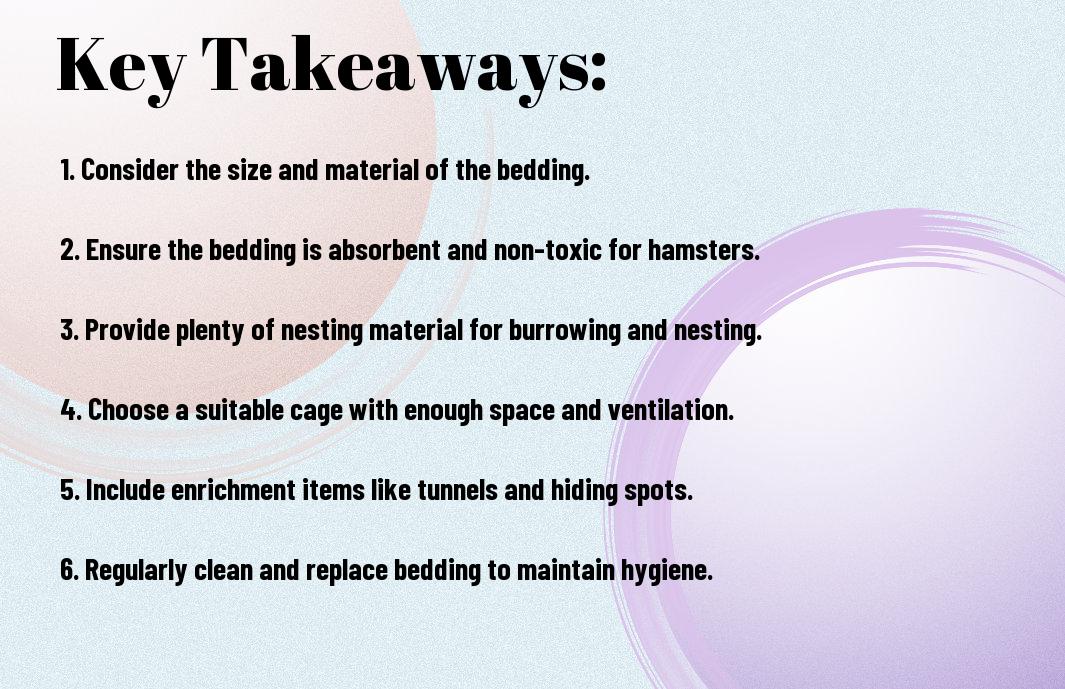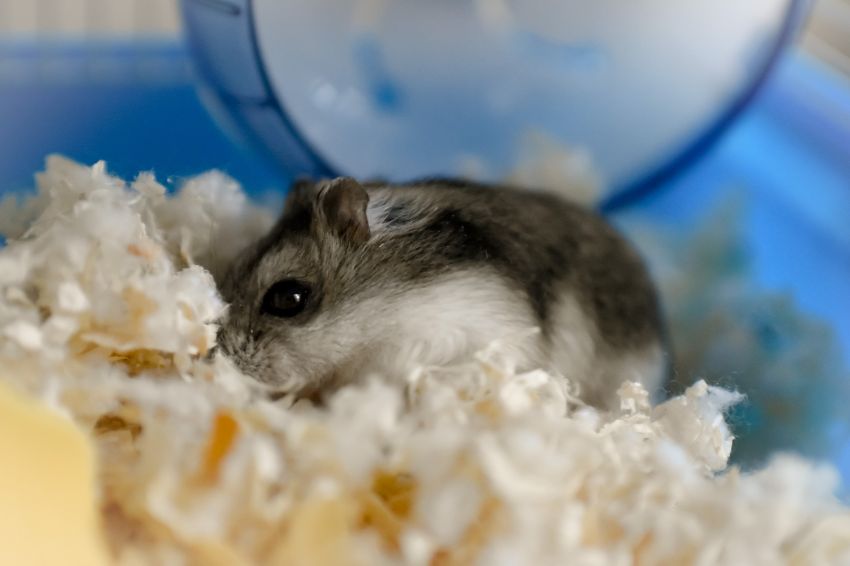When it comes to selecting the best bedding and habitat for your hamster, it’s crucial to make informed decisions in order to ensure your pet’s well-being. Choosing the wrong bedding or habitat can lead to health issues and discomfort for your furry friend. In this blog post, we will guide you through the process of choosing the right type of bedding and habitat for your hamster, covering important factors such as material, size, and safety considerations. By the end of this post, you will have all the necessary information to create the ideal living environment for your hamster.
Key Takeaways:
- Consider your hamster’s natural habitat: When choosing bedding and habitat for your hamster, it is important to consider the natural habitat of the species. Syrian hamsters and dwarf hamsters have different habitat needs, so it is important to choose bedding and habitats that are suitable for their specific needs.
- Choose safe and non-toxic bedding materials: It is important to select bedding materials that are safe and non-toxic for your hamster. Avoid cedar and pine shavings, as they can be harmful to your hamster’s respiratory system. Opt for bedding materials such as aspen shavings, paper-based bedding, or coconut fiber.
- Provide a comfortable and enriching habitat: In addition to bedding, it is important to provide your hamster with a comfortable and enriching habitat. This can include providing tunnels, hiding spots, and toys for your hamster to explore and play with. Additionally, consider providing a solid-bottomed cage to prevent injuries from wire flooring.

Bedding for Your Hamster
One of the most essential components of your hamster’s habitat is the bedding. Not only does it provide a comfortable surface for your hamster to walk and sleep on, but it also helps control odor and absorbs moisture. Choosing the right type of bedding is crucial for the overall well-being of your pet.
Types of Hamster Bedding
When selecting bedding for your hamster, there are several options to consider. Wood shavings such as aspen or pine are a popular choice, as they provide a natural and cozy environment for your hamster. Paper-based bedding is another good option, as it is soft, absorbent, and dust-free. Hay or straw can also be used as bedding, providing a natural and comfortable habitat for your hamster. Commercially available bedding made from materials such as recycled paper or plant-based fibers are also popular. Perceiving the unique needs and preferences of your hamster is essential when selecting the right type of bedding.
Selecting Safe and Comfortable Materials
When choosing bedding for your hamster, it’s important to prioritize safe and comfortable materials. Opt for bedding that is free of perfumes, dyes, and other potentially harmful additives that could irritate your hamster’s respiratory system or skin. Look for bedding that is dust-free to minimize the risk of respiratory issues for your pet. Additionally, consider the softness and absorbency of the bedding to ensure your hamster’s comfort.
Avoiding Harmful Bedding Options
While there are many safe and comfortable bedding options available for your hamster, there are also some that should be avoided. Bedding made from cedar or other aromatic woods should be avoided, as the oils and fragrances can be harmful to your hamster’s respiratory system. Similarly, bedding that contains clay or small particles should be avoided, as these can pose a danger if ingested by your hamster. Always prioritize the safety and well-being of your pet when selecting bedding.
Habitat Essentials
Your hamster’s habitat is a crucial part of their overall wellbeing and happiness. It’s important to create an environment that meets their needs and allows them to thrive. Here are the essential elements to consider when setting up your hamster’s habitat.
Size and Space Requirements
When it comes to choosing the right habitat for your hamster, size matters. It’s important to provide adequate space for your furry friend to move around, explore, and exercise. A good rule of thumb is to provide at least 24 x 12 inches of floor space, with a minimum of 6 inches of bedding for burrowing. Keep in mind that hamsters are active animals that require room to run, climb, and play, so be sure to choose a habitat that allows for ample physical activity.
The Role of Enrichment in Habitats
Enrichment is a vital component of your hamster’s habitat. Providing a variety of toys, tunnels, and hiding spots will keep your hamster mentally stimulated and prevent boredom. Adding a running wheel, chew toys, and items for digging and burrowing will help mimic their natural activities in the wild. Enrichment also plays a key role in preventing stress and promoting overall mental and emotional well-being for your pet.
Location and Setup of Your Hamster’s Habitat
Choosing the right location for your hamster’s habitat is crucial. Place the habitat in a quiet area of your home, away from direct sunlight and drafts. Keep the habitat elevated to prevent it from coming into contact with other pets or young children. Provide a good layer of substrate for burrowing, and consider adding a variety of bedding materials such as paper, wood shavings, or hay to create a comfortable and stimulating environment for your hamster.
Maintenance and Hygiene
However, choosing the right bedding and habitat for your hamster is not enough to ensure their well-being. It is essential to maintain cleanliness and hygiene in their environment to prevent health issues and ensure their overall happiness and comfort.
Cleaning Routines for Bedding and Habitat
It is crucial to establish a regular cleaning routine for your hamster’s bedding and habitat. This includes removing any soiled bedding on a daily basis and replacing it with fresh, clean bedding. Additionally, you should thoroughly clean and disinfect the entire habitat at least once a week to prevent the buildup of bacteria and odors. Remember to use pet-safe cleaning products and rinse thoroughly to ensure there are no harmful residues left behind.
Signs of an Unhealthy Environment
You should also be vigilant for any signs that indicate your hamster’s environment is becoming unhealthy. These signs may include a strong, unpleasant odor coming from the cage, an increase in pest activity such as flies or mites, as well as any changes in your hamster’s behavior or appearance. If you notice any of these signs, it is crucial to address the issue promptly to ensure your hamster’s well-being.
By maintaining a clean and hygienic environment for your hamster, you can ensure that they remain healthy and happy. Regular cleaning routines and monitoring for signs of an unhealthy environment are essential responsibilities that come with owning a pet. Remember that your hamster relies on you to provide them with a safe and comfortable living space, so be diligent in maintaining their habitat.
Shopping for Bedding and Habitat Supplies
Lastly, when it comes to shopping for bedding and habitat supplies for your hamster, it’s important to choose the right products that will provide a comfortable and safe living environment for your furry friend. With so many options available in the market, it can be overwhelming to decide which products to buy. In this chapter, we will explore some tips for choosing the right bedding and habitat supplies for your hamster.
Recommended Brands and Products
When it comes to bedding for your hamster, it’s important to choose products that are safe and comfortable. Look for bedding made from natural materials such as paper, wood shavings, or hay. Avoid bedding that contains cedar or pine shavings as these can release harmful chemicals and oils that can be harmful to your hamster’s respiratory system. Some popular and recommended brands for hamster bedding include Carefresh, Kaytee Clean & Cozy, and Oxbow Pure Comfort. For habitat supplies such as cages, wheels, and hideouts, look for products that are durable, easy to clean, and provide enough room for your hamster to move around and exercise.
Making Economical Choices
When shopping for bedding and habitat supplies for your hamster, it’s important to make economical choices without compromising on quality. Look for bedding that offers good absorbency and odor control to keep your hamster’s habitat clean and fresh. Consider buying bedding in bulk to save money in the long run, and opt for reusable or washable habitat supplies such as plastic hideouts and solid plastic wheels instead of disposable alternatives. Making economical choices will not only save you money but also ensure that you are providing the best for your hamster without overspending.
Choosing the Right Bedding and Habitat for Your Hamster
Hence, when selecting the bedding and habitat for your hamster, it is important to consider the comfort, safety, and natural behaviors of your pet. Providing a suitable bedding material that is absorbent, safe, and non-toxic will ensure a clean and healthy environment for your hamster. Additionally, creating a habitat that allows for exploration, nesting, and play will contribute to your hamster’s well-being and happiness. Prioritizing your hamster’s needs when choosing bedding and habitat will lead to a happy and healthy pet.
FAQ
Q: What bedding is best for my hamster’s habitat?
A: The best bedding for your hamster’s habitat is one that is non-toxic, absorbent, and free of dust. Aspen wood shavings, paper-based bedding, or coconut fiber are all excellent choices. Avoid cedar and pine shavings as the oils in these woods can be harmful to your hamster’s respiratory system.
Q: How do I choose the right habitat for my hamster?
A: When choosing a habitat for your hamster, opt for a spacious cage with a solid bottom to prevent escape and ensure easy cleaning. A wire cage with a plastic base is a good option, ensuring proper ventilation and room for accessories. Avoid aquariums, as they can trap ammonia and restrict airflow.
Q: What accessories should I include in my hamster’s habitat?
A: Essential accessories for your hamster’s habitat include a water bottle, food bowl, exercise wheel, hideout, and chew toys. Provide plenty of bedding for nesting and consider adding tunnels, platforms, and climbing toys to enrich your hamster’s environment. Avoid plastic accessories with sharp edges and opt for safe, easy-to-clean materials like ceramic or stainless steel.














